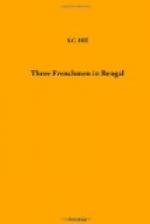The siege was raised, and the Prince’s general, Kamgar Khan, led the army about the country with apparently no object but that of plunder. This suited the Marathas, but did not suit Law. On one occasion he was ordered with his own troops and a body of Marathas to capture the little fort of Soupy. The French stormed it at three o’clock in the morning, but found that the Marathas, who had carefully avoided the breach, had swarmed the walls, where there was no one to oppose them, and were carrying off the plunder.
“My chief occupation and that of the officers, for more than five hours during which we stayed in Soupy, was to keep our soldiers and sepoys from bayoneting the Marathas, who, without having incurred the least danger, had, by their cleverness and lightness, carried off more than twenty times as much as our own men, observing among themselves a kind of order in their plundering, very like that of monkeys when they strip a field.”
In fact, Law had a personal altercation with the Maratha commander about a young and beautiful Hindu woman, whom the Maratha wished to seize, but whom Law was determined to restore unhurt to her relations, who lived in a village close by.
For the capture of the fort, Law received from the Shahzada various high-sounding titles and the right to have the royal music played before him; but as he could not afford to entertain the native musicians, he allowed the privilege to sleep.
In 1760 Mr. Vansittart assumed the Governorship of Bengal, and his first act was to complete the project begun by his predecessor, Mr. Holwell, namely, the dethronement of Mir Jafar. This was effected on the 20th of October, 1760; the ex-Nawab went quietly to Calcutta, and Mir Kasim reigned in his stead. The Shahzada had now become Emperor by the death of his father, and had assumed the title of Shah Alam. He was still hanging with his army round Patna, and Mir Kasim and the English determined to bring him to book. Kamgar Khan continued to lead the Imperial army aimlessly about the country, and in January, 1761, found himself near the town of Bihar. He had 35 to 40 thousand cavalry, maintained chiefly by plunder, but his only musketeers and artillery were those commanded by Law, i.e. 125 Europeans and 200 sepoys, with 18 guns of small calibre. The British commander, Major Carnac, had 650 Europeans and 5 to 6 thousand sepoys, with 12 guns. Mir Kasim had some 20,000 cavalry, and the same number of musketeers, all good troops, for “everybody was paid in the army of Kasim Ali Khan."[114]




